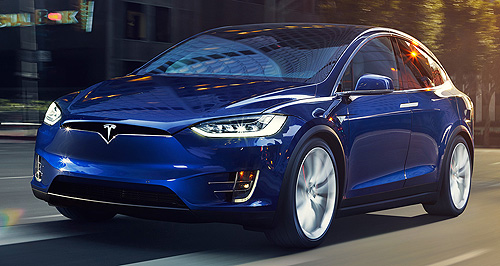Make / Model Search
News - TeslaTesla revamps Autopilot systemZero latency: Tesla’s new Autopilot system will utilise radar instead of cameras to read the road and will process images every tenth of a second for improved autonomous driving. Semi-autonomous mode switches to radar sensing in next iteration of Tesla Autopilot12 Sep 2016 By TUNG NGUYEN TELSA has released an incremental update to its controversial Autopilot self-driving software, switching the system’s primary control sensor from a forward-facing camera to radar, which is expected to prevent crashes similar to the fatal accident in June. The Version 8.0 update also adds other improvements to the Autopilot software including updated automatic lane change, more prominent interface alerts when Autopilot needs to be switched back to manual mode, Autosteer lock-out if drivers ignore warnings, and amplified automatic braking in emergency situations. While radar was a secondary sensor in Autopilot’s initial activation in update 7.0, Tesla will now use it as the main image input sensor in self-driving mode due to its “more advanced signal processing” which can stitch together a better picture of the world around it “without requiring the camera to confirm visual image recognition”. According to the electric vehicle-maker, the new radar system will compare snapshots every tenth of a second to read the road and obstacles ahead more accurately and efficiency. “Software 8.0 unlocks access to six times as many radar objects with the same hardware with a lot more information per object,” it said. “By comparing several contiguous frames against vehicle velocity and expected path, the car can tell if something is real and assess the probability of collision.” The new software suite will also send driving data to Tesla, allowing other models to download and learn from the path of previous vehicles. “Initially, the vehicle fleet will take no action except to note the position of road signs, bridges and other stationary objects, mapping the world according to radar,” it said. “The car computer will then silently compare when it would have braked to the driver action and upload that to the Tesla database. “If several cars drive safely past a given radar object, whether Autopilot is turned on or off, then that object is added to the geocoded whitelist.” Tesla’s radar system is also able to ‘see’ beyond just the vehicle in front as the technology “will also be able to bounce the radar signal under a vehicle in front – using the radar pulse signature and photon time of flight to distinguish the signal,” according to the company. Tesla said it opted for a camera-based system initially due to some of the shortfalls of radar including the system’s issue detecting metallic objects, seeing pedestrians as partially translucent and its inability to read wood and painted plastics. “The big problem in using radar to stop the car is avoiding false alarms,” it said. However, by using both the radar as the primary control sensor and the camera as a supplementary sensor, Tesla believes it has overcome the false braking problems and improved its Autopilot system. Many manufacturers – including Mercedes-Benz, BMW and Volvo – use radar as the primary system for its autonomous emergency braking and guided cruise control systems, while Subaru opts for dual front-facing stereoscopic cameras to control the same systems. In June, a Tesla Model S was involved in a fatal car crash in the United States while Autopilot was engaged due to the camera-based system not being able to differentiate a white truck trailer from the bright, blue sky. Last month, a crash on a Beijing freeway was blamed on Tesla’s Autopilot function because the Model S was not able to avoid a broken down car after the vehicle in front quickly moved out of lane. While Tesla has come under fire for both incidents, the release of the Version 8.0 update addresses criticisms in both incidents.  Read more19th of August 2016  Volvo and Uber ally for autonomous drivingRide-sharing start-up Uber and Swedish car-maker Volvo to develop self-driving cars10th of August 2016  Another Tesla S autopilot crash reportedBeijing freeway crash blamed on Tesla autopilot’s failure to avoid broken-down car1st of July 2016  Tesla Autopilot fatality under investigationNHTSA launches inquiry into Tesla’s self-driving technology after fatal car crash10th of June 2016  Tesla brings back entry-level Model SReturn of Model S 60 lowers entry point to Tesla’s Australian range12th of February 2016  Tesla goes hands-free with Model SAutopilot feature showcased as Tesla headlines Pause Fest tech gathering |
Click to shareTesla articlesResearch Tesla Motor industry news |











Facebook Twitter Instagram